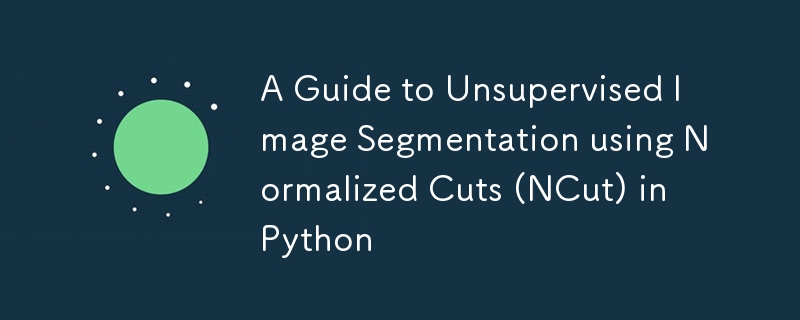在 Python 中使用標準化剪切 (NCut) 進行無監督影像分割的指南

介绍
图像分割在理解和分析视觉数据方面起着至关重要的作用,而归一化剪切(NCut)是一种广泛使用的基于图的分割方法。在本文中,我们将探索如何使用 Microsoft Research 的数据集在 Python 中应用 NCut 进行无监督图像分割,重点是使用超像素提高分割质量。
数据集概述
用于此任务的数据集可以从以下链接下载:MSRC 对象类别图像数据库。该数据集包含原始图像及其语义分割为九个对象类(由以“_GT”结尾的图像文件表示)。这些图像被分组为主题子集,其中文件名中的第一个数字指的是类别子集。该数据集非常适合试验分割任务。
问题陈述
我们使用 NCut 算法对数据集中的图像进行图像分割。像素级分割的计算成本很高,而且通常存在噪声。为了克服这个问题,我们使用 SLIC(简单线性迭代聚类)来生成超像素,它将相似的像素分组并减少问题的大小。为了评估分割的准确性,可以使用不同的指标(例如,并集交集、SSIM、兰德指数)。
执行
1。安装所需的库
我们使用 skimage 进行图像处理,使用 numpy 进行数值计算,使用 matplotlib 进行可视化。
pip install numpy matplotlib pip install scikit-image==0.24.0 **2. Load and Preprocess the Dataset**
下载并提取数据集后,加载图像并进行地面实况分割:
wget http://download.microsoft.com/download/A/1/1/A116CD80-5B79-407E-B5CE-3D5C6ED8B0D5/msrc_objcategimagedatabase_v1.zip -O msrc_objcategimagedatabase_v1.zip unzip msrc_objcategimagedatabase_v1.zip rm msrc_objcategimagedatabase_v1.zip
现在我们准备开始编码了。
from skimage import io, segmentation, color, measure
from skimage import graph
import numpy as np
import matplotlib.pyplot as plt
# Load the image and its ground truth
image = io.imread('/content/MSRC_ObjCategImageDatabase_v1/1_16_s.bmp')
ground_truth = io.imread('/content/MSRC_ObjCategImageDatabase_v1/1_16_s_GT.bmp')
# show images side by side
fig, ax = plt.subplots(1, 2, figsize=(10, 5))
ax[0].imshow(image)
ax[0].set_title('Image')
ax[1].imshow(ground_truth)
ax[1].set_title('Ground Truth')
plt.show()
3.使用 SLIC 生成超像素并创建区域邻接图
我们在应用 NCut 之前使用 SLIC 算法来计算超像素。使用生成的超像素,我们基于平均颜色相似度构建区域邻接图(RAG):
from skimage.util import img_as_ubyte, img_as_float, img_as_uint, img_as_float64 compactness=30 n_segments=100 labels = segmentation.slic(image, compactness=compactness, n_segments=n_segments, enforce_connectivity=True) image_with_boundaries = segmentation.mark_boundaries(image, labels, color=(0, 0, 0)) image_with_boundaries = img_as_ubyte(image_with_boundaries) pixel_labels = color.label2rgb(labels, image_with_boundaries, kind='avg', bg_label=0
紧凑性控制形成超像素时像素的颜色相似度和空间接近度之间的平衡。它决定了对保持超像素紧凑(在空间方面更接近)与确保它们按颜色更均匀分组的重视程度。
较高的值:较高的紧凑度值会导致算法优先创建空间紧凑且大小均匀的超像素,而较少关注颜色相似性。这可能会导致超像素对边缘或颜色渐变不太敏感。
较低的值:较低的紧凑度值允许超像素在空间尺寸上变化更大,以便更准确地考虑颜色差异。这通常会导致超像素更紧密地遵循图像中对象的边界。
n_segments 控制 SLIC 算法尝试在图像中生成的超像素(或段)的数量。本质上,它设置了分割的分辨率。
较高的值:较高的 n_segments 值会创建更多的超像素,这意味着每个超像素会更小,分割会更细粒度。当图像具有复杂纹理或小对象时,这非常有用。
较低的值:较低的 n_segments 值会产生更少、更大的超像素。当您想要对图像进行粗分割,将较大的区域分组为单个超像素时,这非常有用。
4。应用标准化剪切 (NCut) 并可视化结果
# using the labels found with the superpixeled image
# compute the Region Adjacency Graph using mean colors
g = graph.rag_mean_color(image, labels, mode='similarity')
# perform Normalized Graph cut on the Region Adjacency Graph
labels2 = graph.cut_normalized(labels, g)
segmented_image = color.label2rgb(labels2, image, kind='avg')
f, axarr = plt.subplots(nrows=1, ncols=4, figsize=(25, 20))
axarr[0].imshow(image)
axarr[0].set_title("Original")
#plot boundaries
axarr[1].imshow(image_with_boundaries)
axarr[1].set_title("Superpixels Boundaries")
#plot labels
axarr[2].imshow(pixel_labels)
axarr[2].set_title('Superpixel Labels')
#compute segmentation
axarr[3].imshow(segmented_image)
axarr[3].set_title('Segmented image (normalized cut)')
5。评估指标
无监督分割的关键挑战是 NCut 不知道图像中类别的确切数量。 NCut 找到的分段数量可能超过实际的地面实况区域数量。因此,我们需要强大的指标来评估细分质量。
并集交集 (IoU) 是一种广泛使用的评估分割任务的指标,特别是在计算机视觉领域。它测量预测分割区域和地面真实区域之间的重叠。具体来说,IoU 计算预测分割和真实数据之间的重叠面积与其并集面积的比率。
结构相似性指数 (SSIM) 是一种用于通过比较两个图像的亮度、对比度和结构来评估图像感知质量的指标。
要应用这些指标,我们需要预测和地面实况图像具有相同的标签。为了计算标签,我们在地面上计算一个掩模,并在预测时为图像上找到的每种颜色分配一个 ID
然而,使用 NCut 进行分割可能会发现比地面实况更多的区域,这会降低准确性。
def compute_mask(image):
color_dict = {}
# Get the shape of the image
height,width,_ = image.shape
# Create an empty array for labels
labels = np.zeros((height,width),dtype=int)
id=0
# Loop over each pixel
for i in range(height):
for j in range(width):
# Get the color of the pixel
color = tuple(image[i,j])
# Check if it is in the dictionary
if color in color_dict:
# Assign the label from the dictionary
labels[i,j] = color_dict[color]
else:
color_dict[color]=id
labels[i,j] = id
id =1
return(labels)
def show_img(prediction, groundtruth):
f, axarr = plt.subplots(nrows=1, ncols=2, figsize=(15, 10))
axarr[0].imshow(groundtruth)
axarr[0].set_title("groundtruth")
axarr[1].imshow(prediction)
axarr[1].set_title(f"prediction")
prediction_mask = compute_mask(segmented_image)
groundtruth_mask = compute_mask(ground_truth)
#usign the original image as baseline to convert from labels to color
prediction_img = color.label2rgb(prediction_mask, image, kind='avg', bg_label=0)
groundtruth_img = color.label2rgb(groundtruth_mask, image, kind='avg', bg_label=0)
show_img(prediction_img, groundtruth_img)
现在我们计算准确度分数
from sklearn.metrics import jaccard_score
from skimage.metrics import structural_similarity as ssim
ssim_score = ssim(prediction_img, groundtruth_img, channel_axis=2)
print(f"SSIM SCORE: {ssim_score}")
jac = jaccard_score(y_true=np.asarray(groundtruth_mask).flatten(),
y_pred=np.asarray(prediction_mask).flatten(),
average = None)
# compute mean IoU score across all classes
mean_iou = np.mean(jac)
print(f"Mean IoU: {mean_iou}")
结论
标准化剪切是一种强大的无监督图像分割方法,但它也面临着过度分割和调整参数等挑战。通过合并超像素并使用适当的指标评估性能,NCut 可以有效地分割复杂图像。 IoU 和 Rand 指数指标为分割质量提供了有意义的见解,尽管需要进一步细化才能有效处理多类场景。
最后,我的笔记本中提供了一个完整的示例。
-
 C++成員函數指針正確傳遞方法如何將成員函數置於c 的函數時,接受成員函數指針的函數時,必須同時提供對象的指針,並提供指針和指針到函數。需要具有一定簽名的功能指針。要通過成員函數,您需要同時提供對象指針(此)和成員函數指針。這可以通過修改Menubutton :: SetButton()(如下所示:[&& && && &&華)...程式設計 發佈於2025-07-12
C++成員函數指針正確傳遞方法如何將成員函數置於c 的函數時,接受成員函數指針的函數時,必須同時提供對象的指針,並提供指針和指針到函數。需要具有一定簽名的功能指針。要通過成員函數,您需要同時提供對象指針(此)和成員函數指針。這可以通過修改Menubutton :: SetButton()(如下所示:[&& && && &&華)...程式設計 發佈於2025-07-12 -
 如何正確使用與PDO參數的查詢一樣?在pdo 中使用類似QUERIES在PDO中的Queries時,您可能會遇到類似疑問中描述的問題:此查詢也可能不會返回結果,即使$ var1和$ var2包含有效的搜索詞。錯誤在於不正確包含%符號。 通過將變量包含在$ params數組中的%符號中,您確保將%字符正確替換到查詢中。沒有此修改,PD...程式設計 發佈於2025-07-12
如何正確使用與PDO參數的查詢一樣?在pdo 中使用類似QUERIES在PDO中的Queries時,您可能會遇到類似疑問中描述的問題:此查詢也可能不會返回結果,即使$ var1和$ var2包含有效的搜索詞。錯誤在於不正確包含%符號。 通過將變量包含在$ params數組中的%符號中,您確保將%字符正確替換到查詢中。沒有此修改,PD...程式設計 發佈於2025-07-12 -
 解決MySQL插入Emoji時出現的\\"字符串值錯誤\\"異常Resolving Incorrect String Value Exception When Inserting EmojiWhen attempting to insert a string containing emoji characters into a MySQL database us...程式設計 發佈於2025-07-12
解決MySQL插入Emoji時出現的\\"字符串值錯誤\\"異常Resolving Incorrect String Value Exception When Inserting EmojiWhen attempting to insert a string containing emoji characters into a MySQL database us...程式設計 發佈於2025-07-12 -
 Java的Map.Entry和SimpleEntry如何簡化鍵值對管理?A Comprehensive Collection for Value Pairs: Introducing Java's Map.Entry and SimpleEntryIn Java, when defining a collection where each element com...程式設計 發佈於2025-07-12
Java的Map.Entry和SimpleEntry如何簡化鍵值對管理?A Comprehensive Collection for Value Pairs: Introducing Java's Map.Entry and SimpleEntryIn Java, when defining a collection where each element com...程式設計 發佈於2025-07-12 -
 如何使用Depimal.parse()中的指數表示法中的數字?在嘗試使用Decimal.parse(“ 1.2345e-02”中的指數符號表示法表示的字符串時,您可能會遇到錯誤。這是因為默認解析方法無法識別指數符號。 成功解析這樣的字符串,您需要明確指定它代表浮點數。您可以使用numbersTyles.Float樣式進行此操作,如下所示:[&& && && ...程式設計 發佈於2025-07-12
如何使用Depimal.parse()中的指數表示法中的數字?在嘗試使用Decimal.parse(“ 1.2345e-02”中的指數符號表示法表示的字符串時,您可能會遇到錯誤。這是因為默認解析方法無法識別指數符號。 成功解析這樣的字符串,您需要明確指定它代表浮點數。您可以使用numbersTyles.Float樣式進行此操作,如下所示:[&& && && ...程式設計 發佈於2025-07-12 -
 如何使用FormData()處理多個文件上傳?)處理多個文件輸入時,通常需要處理多個文件上傳時,通常是必要的。 The fd.append("fileToUpload[]", files[x]); method can be used for this purpose, allowing you to send multi...程式設計 發佈於2025-07-12
如何使用FormData()處理多個文件上傳?)處理多個文件輸入時,通常需要處理多個文件上傳時,通常是必要的。 The fd.append("fileToUpload[]", files[x]); method can be used for this purpose, allowing you to send multi...程式設計 發佈於2025-07-12 -
 為什麼在我的Linux服務器上安裝Archive_Zip後,我找不到“ class \” class \'ziparchive \'錯誤?Class 'ZipArchive' Not Found Error While Installing Archive_Zip on Linux ServerSymptom:When attempting to run a script that utilizes the ZipAr...程式設計 發佈於2025-07-12
為什麼在我的Linux服務器上安裝Archive_Zip後,我找不到“ class \” class \'ziparchive \'錯誤?Class 'ZipArchive' Not Found Error While Installing Archive_Zip on Linux ServerSymptom:When attempting to run a script that utilizes the ZipAr...程式設計 發佈於2025-07-12 -
 圖片在Chrome中為何仍有邊框? `border: none;`無效解決方案在chrome 中刪除一個頻繁的問題時,在與Chrome and IE9中的圖像一起工作時,遇到了一個頻繁的問題。和“邊境:無;”在CSS中。要解決此問題,請考慮以下方法: Chrome具有忽略“ border:none; none;”的已知錯誤,風格。要解決此問題,請使用以下CSS ID塊創建帶...程式設計 發佈於2025-07-12
圖片在Chrome中為何仍有邊框? `border: none;`無效解決方案在chrome 中刪除一個頻繁的問題時,在與Chrome and IE9中的圖像一起工作時,遇到了一個頻繁的問題。和“邊境:無;”在CSS中。要解決此問題,請考慮以下方法: Chrome具有忽略“ border:none; none;”的已知錯誤,風格。要解決此問題,請使用以下CSS ID塊創建帶...程式設計 發佈於2025-07-12 -
 為什麼Microsoft Visual C ++無法正確實現兩台模板的實例?The Mystery of "Broken" Two-Phase Template Instantiation in Microsoft Visual C Problem Statement:Users commonly express concerns that Micro...程式設計 發佈於2025-07-12
為什麼Microsoft Visual C ++無法正確實現兩台模板的實例?The Mystery of "Broken" Two-Phase Template Instantiation in Microsoft Visual C Problem Statement:Users commonly express concerns that Micro...程式設計 發佈於2025-07-12 -
 對象擬合:IE和Edge中的封面失敗,如何修復?To resolve this issue, we employ a clever CSS solution that solves the problem:position: absolute;top: 50%;left: 50%;transform: translate(-50%, -50%)...程式設計 發佈於2025-07-12
對象擬合:IE和Edge中的封面失敗,如何修復?To resolve this issue, we employ a clever CSS solution that solves the problem:position: absolute;top: 50%;left: 50%;transform: translate(-50%, -50%)...程式設計 發佈於2025-07-12 -
 如何在JavaScript對像中動態設置鍵?在嘗試為JavaScript對象創建動態鍵時,如何使用此Syntax jsObj['key' i] = 'example' 1;不工作。正確的方法採用方括號: jsobj ['key''i] ='example'1; 在JavaScript中,數組是一...程式設計 發佈於2025-07-12
如何在JavaScript對像中動態設置鍵?在嘗試為JavaScript對象創建動態鍵時,如何使用此Syntax jsObj['key' i] = 'example' 1;不工作。正確的方法採用方括號: jsobj ['key''i] ='example'1; 在JavaScript中,數組是一...程式設計 發佈於2025-07-12 -
 如何實時捕獲和流媒體以進行聊天機器人命令執行?在開發能夠執行命令的chatbots的領域中,實時從命令執行實時捕獲Stdout,一個常見的需求是能夠檢索和顯示標準輸出(stdout)在cath cath cant cant cant cant cant cant cant cant interfaces in Chate cant inter...程式設計 發佈於2025-07-12
如何實時捕獲和流媒體以進行聊天機器人命令執行?在開發能夠執行命令的chatbots的領域中,實時從命令執行實時捕獲Stdout,一個常見的需求是能夠檢索和顯示標準輸出(stdout)在cath cath cant cant cant cant cant cant cant cant interfaces in Chate cant inter...程式設計 發佈於2025-07-12 -
 Async Void vs. Async Task在ASP.NET中:為什麼Async Void方法有時會拋出異常?在ASP.NET async void void async void void void void void的設計無需返回asynchroncon而無需返回任務對象。他們在執行過程中增加未償還操作的計數,並在完成後減少。在某些情況下,這種行為可能是有益的,例如未期望或明確預期操作結果的火災和...程式設計 發佈於2025-07-12
Async Void vs. Async Task在ASP.NET中:為什麼Async Void方法有時會拋出異常?在ASP.NET async void void async void void void void void的設計無需返回asynchroncon而無需返回任務對象。他們在執行過程中增加未償還操作的計數,並在完成後減少。在某些情況下,這種行為可能是有益的,例如未期望或明確預期操作結果的火災和...程式設計 發佈於2025-07-12 -
 Python讀取CSV文件UnicodeDecodeError終極解決方法在試圖使用已內置的CSV模塊讀取Python中時,CSV文件中的Unicode Decode Decode Decode Decode decode Error讀取,您可能會遇到錯誤的錯誤:無法解碼字節 在位置2-3中:截斷\ uxxxxxxxx逃脫當CSV文件包含特殊字符或Unicode的路徑逃...程式設計 發佈於2025-07-12
Python讀取CSV文件UnicodeDecodeError終極解決方法在試圖使用已內置的CSV模塊讀取Python中時,CSV文件中的Unicode Decode Decode Decode Decode decode Error讀取,您可能會遇到錯誤的錯誤:無法解碼字節 在位置2-3中:截斷\ uxxxxxxxx逃脫當CSV文件包含特殊字符或Unicode的路徑逃...程式設計 發佈於2025-07-12
學習中文
- 1 走路用中文怎麼說? 走路中文發音,走路中文學習
- 2 坐飛機用中文怎麼說? 坐飞机中文發音,坐飞机中文學習
- 3 坐火車用中文怎麼說? 坐火车中文發音,坐火车中文學習
- 4 坐車用中文怎麼說? 坐车中文發音,坐车中文學習
- 5 開車用中文怎麼說? 开车中文發音,开车中文學習
- 6 游泳用中文怎麼說? 游泳中文發音,游泳中文學習
- 7 騎自行車用中文怎麼說? 骑自行车中文發音,骑自行车中文學習
- 8 你好用中文怎麼說? 你好中文發音,你好中文學習
- 9 謝謝用中文怎麼說? 谢谢中文發音,谢谢中文學習
- 10 How to say goodbye in Chinese? 再见Chinese pronunciation, 再见Chinese learning

























